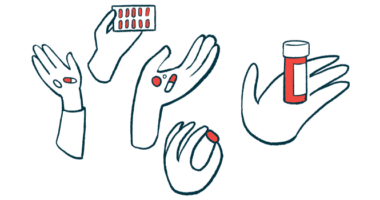Approved Treatments for LEMS
Overview
Lambert-Eaton myasthenic syndrome (LEMS) is a rare disease in which the immune system mistakenly attacks a protein on the nerve endings, resulting in muscle weakness and other symptoms. There is currently no cure for LEMS, but there are treatments to manage symptoms and improve patients’ quality of life. Scroll down to learn more about some of the ways LEMS can be treated.
Firdapse
Firdapse (amifampridine) is an oral therapy for the symptomatic treatment of Lambert-Eaton myasthenic syndrome (LEMS). The therapy works to improve muscle strength and mobility in adults and children with the autoimmune disease. It is given in the form of oral tablets to be taken by mouth.
Guanidine
Guanidine is a small molecule oral medication that has been used to treat the symptoms of LEMS, although, due severe side effects, it is not the preferred treatment for the disorder. Guanadine may improve muscle function by binding to potassium channels and prolonging the nerve signal. This facilitates the absorption of calcium by the remaining healthy calcium channels.
Cholinesterase Inhibitors
In LEMS, muscles weaken and atrophy as the immune system attacks the nerve cell endings, weakening nerve signals. Cholinesterase inhibitors block the enzyme that breaks down acetylcholine, meaning that a stronger, longer-lasting nerve signal can be sent. These medications are prescribed off-label for LEMS, with pyridostigmine the most commonly used.
Immunosuppressants
Medications known as immunosuppressants can be used in autoimmune diseases such as LEMS to reduce the severity of symptoms. LEMS is caused by the body’s immune system mistakenly attacking the nerve cell endings, leading to the destruction of calcium channels that release the neurotransmitter, or cell-signaling molecule, acetylcholine. Immunosuppressants work by suppressing the activity of the immune system so that the autoimmune attack on the nerve cell endings is reduced.
Azathioprine
Azathioprine is used to prevent organ rejection following a transplant and to treat certain autoimmune conditions. If symptoms are not sufficiently controlled by first-line treatment with Firdapse, patients may receive long-term treatment with the immunosuppressive medications prednisone and azathioprine.
Mycophenolate
Mycophenolate is an oral medication that dampens immune system reactions by blocking the function of inosine monophosphate dehydrogenase. Another mechanism of action described for mycophenolate is the disintegration of activated T-cells, which are immune cells programmed to attack a particular target, like nerve cell endings in the case of LEMS.
Prednisone
Prednisone is a man-made corticosteroid used in the treatment of LEMS. It acts in a similar way to the corticosteroid hormones synthesized by the outer layer of the adrenal glands, such as cortisol. Prednisone has anti-immune and anti-inflammatory effects; it suppresses the production of autoantibodies by immune system cells called B-cells, thereby alleviating LEMS symptoms.
Rituximab
Rituximab is a treatment option for patients with LEMS who do not respond to standard immunosuppressive therapy. Rituximab is a monoclonal antibody that binds to a specific protein — CD20 — present on the surface of B-cells. This binding triggers the disintegration of B-cells, thereby decreasing their number in the blood and dampening their attack on the neuromuscular junction.
Other Treatments
Other treatments that may be beneficial for LEMS patients include IVIG replacement therapy and plasmapheresis. Both procedures are designed to combat the presence of autoantibodies in the blood to ease disease symptoms. These treatments provide only temporary relief and need to be repeated regularly.
IVIG Replacement Therapy
Intravenous immunoglobulin (IVIG) replacement therapy is approved in the U.S. to treat patients with compromised immune systems. The therapy also can be used to treat LEMS. IVIG is a component prepared from human blood. Using donor blood, antibodies of a particular type — immunoglobulins — are isolated and purified of potential contaminants, such as other blood components. This mixture of antibodies is injected directly into the bloodstream of a LEMS patient.
Plasmapheresis
Plasmapheresis, or plasma exchange, is a treatment commonly used in autoimmune diseases to remove circulating harmful antibodies — known as autoantibodies — that mistakenly recognize the body’s own proteins as foreign. It is generally used to stabilize LEMS patients and restore the normal signaling between the nerve cells and the muscle cells at the neuromuscular junctions. That, in turn, improves muscle contraction.






